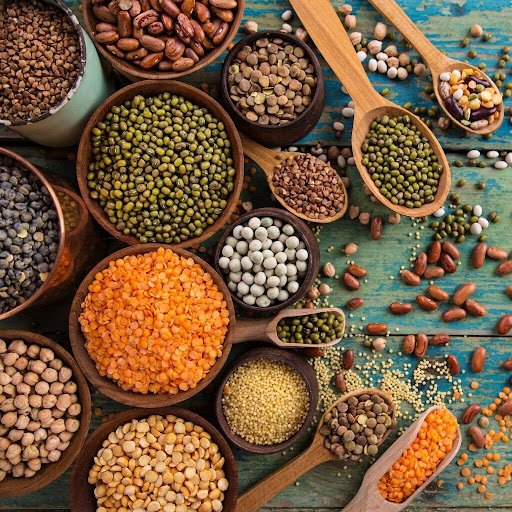In this blog, we have explained 50 English pulse names accompanied by pictures, shedding light on the diverse world of pulses. Understanding these varieties is crucial for both culinary enthusiasts and nutrition-conscious individuals, as pulses play a significant role in enhancing the flavour of dishes and providing essential nutrients. Join us on this visual journey through the realm of pulses and broaden your culinary and nutritional horizons.

List of 50 Pulses Names in English
- Chickpeas
- Lentils
- Black-eyed peas
- Split peas
- Kidney beans
- Pinto beans
- Black beans
- Navy beans
- Mung beans
- Fava beans
- Adzuki beans
- Lima beans
- Garbanzo beans
- Red lentils
- Green lentils
- Yellow lentils
- Brown lentils
- White beans
- Cranberry beans
- Butter beans
- annellini beans
- Great Northern beans
- Soybeans
- Edamame
- Black gram (Urad dal)
- Bengal gram (Chana dal)
- Yellow split peas
- Green split peas
- Masoor dal
- Moong dal
- Toor dal
- Horse gram
- White lentils (Urad dal)
- Yellow moong dal
- Red kidney beans
- Black lentils (Beluga lentils)
- Garbanzo bean flour
- Peanuts
- Matar dal
- White kidney beans
- French green lentils (Puy lentils)
- Red beans
- Green gram dal
- Cowpeas
- Red cowpeas
- Pink lentils
- lack matpe
- Yellow eye beans
- Scarlet runner beans
- Navy Beans
Categories of Pulses
The following is a categorization of various pulses along with their characteristics and common uses:
Chickpeas (Garbanzo Beans):
The chickpeas are round, beige-coloured legumes with a nutty flavour. They come in two main varieties desi and kabuli. Desi chickpeas are smaller, darker, and have a more robust taste, while kabuli chickpeas are larger, creamier, and milder. Common uses include hummus, salads, curries, and snacks.
Lentils:
The Lentils are lens-shaped seeds available in various colours, including red, green, brown, and black. They are quick-cooking and rich in protein and iron. Red lentils are commonly used in soups and stews, while green and brown lentils are suitable for salads and side dishes.
Black-eyed Peas:
The Black-eyed peas are small, white legumes with a distinctive black spot. They have a mild flavour and are often used in Southern cuisines, such as a side dish.
Split Peas:
The Split peas are dried, hulled peas that are split in half. They come in yellow and green varieties. Yellow split peas are often used in soups and Indian dals, while green split peas are popular in European and North American dishes.
Kidney Beans:
This Kidney beans are large, kidney-shaped legumes with a robust flavour. They are commonly used in chilli, salads, and Mexican dishes. Kidney beans are an excellent source of protein, fibre, and various vitamins and minerals.
Pinto Beans:
The Pinto beans are small, speckled legumes with a creamy texture when cooked. They are a staple in Mexican cuisine, used in dishes like refried beans, burritos, and soups.
Black Beans:
The Black beans have a black colour and a sweet, earthy flavour. They are commonly used in Latin American cuisine, such as in rice and bean dishes, salads, and soups.
Navy Beans:
The Navy beans are small, oval-shaped white beans that are popular in baked bean dishes. They have a mild taste and a creamy texture when cooked.
Mung Beans:
All the Mung beans are small, green legumes commonly used in Asian cuisine. They are often sprouted and used in salads, stir-fries, and curries.
Fava Beans:
The Fava beans, also known as broad beans, have a buttery texture and a slightly bitter taste. They are used in Mediterranean and Middle Eastern cuisines in dishes like salads.
Adzuki Beans:
The Adzuki beans are small, red legumes with a slightly sweet flavour. They are commonly used in East Asian desserts, soups, and sweet bean pastes.
Lima Beans:
The Lima beans are large, flat, green or white legumes with a buttery texture. They are used in succotash, stews, and casseroles.
Red Lentils:
The Red lentils are hulled and split red lentils with a mild, sweet flavour. They cook quickly and are commonly used in Indian and Middle Eastern dishes.
Green Lentils:
This Green lentils are small, green or brown legumes with a peppery flavour. They hold their shape well when cooked and are suitable for salads and side dishes.
Yellow Lentils:
This Yellow lentils are hulled and split yellow lentils with a mild flavour. They are commonly used in Indian dals and soups.
Brown Lentils:
Brown lentils are versatile and hold their shape well when cooked. They are suitable for salads, soups, and side dishes.
White Beans:
White beans, including cannellini and Great Northern beans, are mild-flavoured legumes commonly used in Italian and Mediterranean cuisine. They are used in soups, stews, and salads.
Cranberry Beans:
Cranberry beans are medium-sized beans with a creamy texture and a mottled appearance. They commonly appear in Portuguese and Italian cuisines.
Butter Beans:
Butter beans are large, flat, creamy legumes with a buttery texture. They are often used in Southern cooking, such as succotash and casseroles.
Cannellini Beans:
Cannellini beans are large, white beans with a mild flavour. They are commonly used in Italian dishes.
Great Northern Beans:
Great Northern beans are small, white beans with a mild flavour. They are versatile and can be used in various dishes like casseroles, soups, and salads.
Soybeans:
Soybeans are a versatile legume with a high protein content. They are the foundation of various soy products such as tofu, tempeh, and soy milk.
Edamame:
Edamame is young, green soybeans in the pod. Typically, they are served as a starter or snack after being boiled or steamed.
Black Gram (Urad Dal):
Black gram, also known as urad dal, is a small black bean commonly used in Indian cuisine, particularly in dishes like dal makhani.
Bengal Gram (Chana Dal):
Bengal gram, or chana dal, is a split and hulled chickpea used in Indian cooking, often in soups, stews, and snacks.
Yellow Split Peas:
Yellow split peas are hulled and split yellow peas used in a variety of dishes, including soups and Indian dals.
Green Split Peas:
Green split peas are dried and split green peas commonly used in soups and stews.
Masoor Dal:
Masoor dal is a type of lentil, often red or orange in colour, commonly used in Indian cooking in various lentil-based dishes.
Moong Dal:
Moong dal, made from split and hulled mung beans, is a staple in Indian cuisine, used in dals, curries, and desserts.
Toor Dal:
Toor dal, also known as pigeon pea lentils, is commonly used in Indian cooking to make flavorful dals.
Horse Gram:
Horse gram is a lesser-known legume with a nutty flavour, often used in South Indian cuisine in dishes like rasam.
White Lentils (Urad Dal):
White lentils, made from split and hulled black gram, are commonly used in Indian dishes like dosa and idli batter.
Yellow Moong Dal:
Yellow moong dal, made from split and hulled yellow mung beans, is a versatile ingredient used in various Indian dishes.
Red Kidney Beans:
Red kidney beans are kidney-shaped legumes with a robust flavour, commonly used in chilli, stews, and salads.
Black Lentils (Beluga Lentils):
Black lentils, also known as beluga lentils, are small, black, and resemble caviar when cooked. They are often used in salads and side dishes.
Garbanzo Bean Flour:
Garbanzo bean flour, also known as besan or chickpea flour, is a gluten-free flour commonly used in Indian and Middle Eastern cuisines for making batters, flatbreads, and snacks.
Peanuts:
Peanuts, though technically legumes, are often grouped with nuts. They are a versatile ingredient used in snacks, peanut butter, and various dishes.
Matar Dal:
Matar dal is made from split and hulled yellow peas and is commonly used in Indian cooking.
White Kidney Beans:
White kidney beans, similar to cannellini beans, are used in various dishes such as salads, soups, and casseroles.
French Green Lentils (Puy Lentils):
Puy lentils, also known as French green lentils, have a peppery flavour and hold their shape well when cooked. They are often used in salads and side dishes.
Red Beans:
Red beans, commonly used in Caribbean and Creole cuisines, are versatile and can be used in stews, rice and bean dishes, and salads.
Green Gram Dal:
Green gram dal, made from green mung beans, is commonly used in Indian cooking, particularly in soups and dals.
Cowpeas:
Cowpeas, also known as black-eyed peas, are commonly used in Southern cuisine in dishes like Hoppin’ John.
Red Cowpeas:
Red cowpeas, similar to black-eyed peas, are used in various dishes, including stews and salads.
Pink Lentils:
Pink lentils, with a delicate flavour, are often used in Indian and Middle Eastern cuisines in soups and stews.
Black Matpe:
Black matpe, also known as urad dal, is a black legume commonly used in Indian cuisine, especially in dishes like dosa and idli.
Yellow Eye Beans:
Yellow eye beans are small, cream-coloured beans often used in stews, soups, and casseroles.
Scarlet Runner Beans:
Scarlet runner beans, with their vibrant red colour, are used in various dishes such as salads, stews, and casseroles.
Navy Beans:
Navy beans, small and white, are commonly used in baked beans and soups.
Nutritional Benefits
Pulses are nutritional powerhouses, rich in protein, essential for muscle repair and overall body function. Their high fibre content aids digestion and supports heart health while being a valuable source of minerals like iron and zinc, crucial for overall well-being. Incorporating pulses into your diet enhances nutritional intake, promoting a balanced and healthy lifestyle.
Culinary Uses
Chickpeas: These are commonly used in Mediterranean cuisine for hummus and falafel, try roasting chickpeas with spices for a crunchy snack.
Lentils: They are found in Indian dal dishes and Italian soups, make a hearty lentil stew with vegetables and herbs.
Black Beans: A staple in Latin American cuisine for rice and beans, create a flavorful black bean salsa for tacos or serve as a side dish.
Fun Facts
Chickpeas, also known as garbanzo beans, were first cultivated in the Middle East around 7,000 years ago, making them one of the oldest crops. Additionally, lentils come in various colours, with green and brown being the most common, and they are a powerhouse of protein, fibre, and essential nutrients.
Conclusion
In Conclusion, pulses are nutritional powerhouses, rich in protein, fibre, and essential nutrients, promoting heart health and weight management. Embrace the health benefits by incorporating diverse pulses into your meals for a well-rounded and nutritious diet.
For further exploration of educational content and insights, delve into the resources available on Chrysalis High.
FAQs
Are pulses suitable for vegetarians and vegans?
Yes.
Where can I find these pulses in my local grocery store or market?
You can find pulses in the dried or canned goods section of your local grocery store or market.
Do I need to soak pulses before cooking them?
Yes, because it reduces cooking time and aids in digestion.


